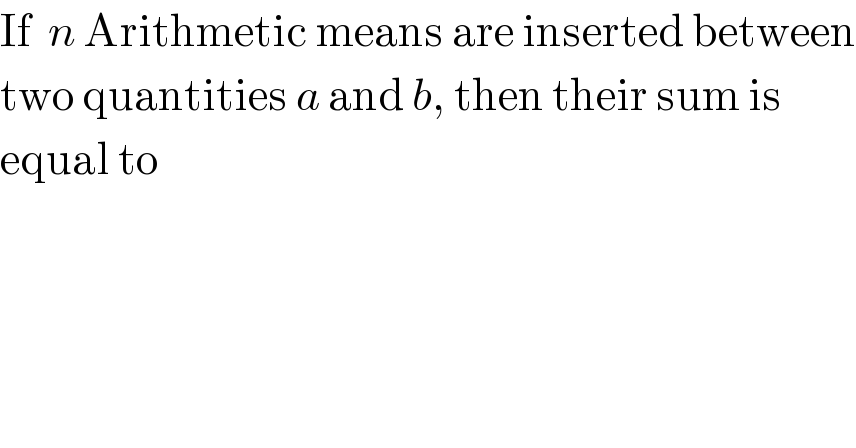Question Number 7522 by Little last updated on 02/Sep/16

Commented by sandy_suhendra last updated on 02/Sep/16

Commented by Rohit last updated on 03/Sep/16

Answered by Rasheed Soomro last updated on 02/Sep/16
![Let A_1 ,A_2 ,A_3 ,...A_n are n AM ′s between a and b. a,A_1 ,A_2 ,A_3 ,...A_n ,b are in AP Let d be common fiffrrnce a+(n+2−1)d =(n+2)th term=b d=((b−a)/(n+1)) A_1 =a+((b−a)/(n+1)) , A_2 =a+2(((b−a)/(n+1))) , A_3 =a+3(((b−a)/(n+1))) ,.... A_n =a+n(((b−a)/(n+1))) S=(n/2)[2a+(n−1)d] S=(n/2)[2A_1 +(n−1)d] S=(n/2)[2(a+((b−a)/(n+1)))+(n−1)(((b−a)/(n+1)))] S=(n/2)[2a+2(((b−a)/(n+1)))+(n−1)(((b−a)/(n+1)))] S=(n/2)[2a+(((b−a)/(n+1)))[2+n−1]] S=(n/2)[2a+(((b−a)/(n+1)))[n+1]] S=(n/2)[2a+b−a] S=(n/2)[a+b]](https://www.tinkutara.com/question/Q7539.png)
Commented by sandy_suhendra last updated on 03/Sep/16
![what′s the meaning of the question? A_1 +A_2 +...+An or a+A_1 +A_2 +...+A_n +b ? Sorry, my English is poor if a+A_1 +...A_n +b in a, A_1 , A_2 , ..., An, b there are (n+2) terms so S=(n/2)[2a+(n−1)d] becomes S=((n+2)/2)[2a+(n+2−1)d]](https://www.tinkutara.com/question/Q7572.png)
Commented by Rasheed Soomro last updated on 04/Sep/16

